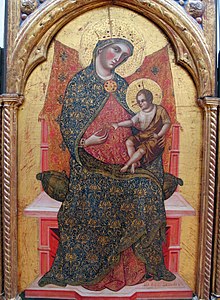
Paolo Veneziano, also Veneziano Paolo or Paolo da Venezia (active by 1333, died after 1358) was a 14th-century painter from Venice, the "founder of the Venetian School" of painting, probably active between about 1321 and 1362.[1][2] He has been called 'the most important Venetian painter of the 14th century'.[3] His many signed and dated works, some in collaboration with his sons, range between 1333 and 1358.[4] He was regarded as the official painter of the Venetian Republic.[5]

He led the development in Venice of the elaborately-framed polyptych or "composite altarpiece" form, which became popular all over Italy during the 13th century, partly in response to liturgical changes (only reversed in the 20th century) which placed the priest celebrating mass on the same side of the altar as the congregation, so with his back to them for much of the time. This encouraged the creation of altarpieces behind and above the altar, as a visual devotional focus.[6] He is the oldest Venetian painter whose name is known, and the earliest to paint the new subject of the Coronation of the Virgin.[7][8]
His style is "still Byzantine", that is to say Italo-Byzantine, but increasingly influenced by the Gothic art developing north of the Alps, and personal elements. However, influence from Giotto is "almost entirely absent".[9]
- ^ Steer, 15
- ^ Paolo Veneziano in: Federico Zeri, with the assistance of Elizabeth E. Gardner, Italian paintings : a catalogue of the collection of the Metropolitan Museum of Art : Venetian school, p. 47-48
- ^ The Random House Library of Painting and Sculpture: Dictionary of artists and art terms David Piper, Random House, 1981 ISBN 0-394-52131-5
- ^ Steer, 15
- ^ Robert Gibbs. "Paolo Veneziano." Grove Art Online. Oxford Art Online. Oxford University Press. Web. 23 Mar. 2016
- ^ Steer, 15-18
- ^ Venice: Mundus Alter
- ^ Nico Muhly and Xavier F. Salomon, Paolo Veneziano’s Coronation of the Virgin. The Frick Collection, 2022.
- ^ Steer, 18-22